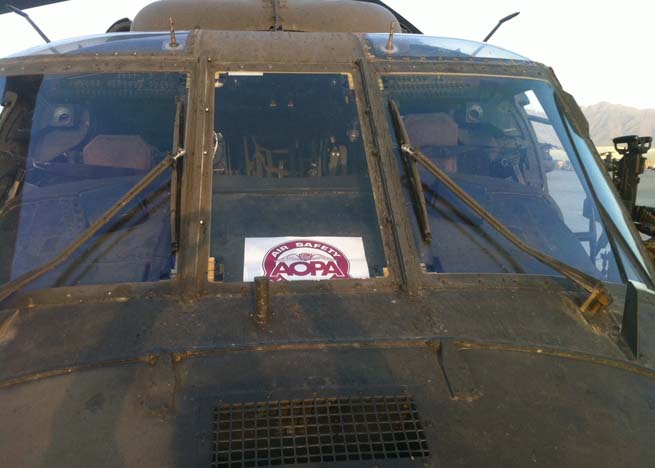
Even though soldiers are in Afghanistan, the Department of Army Standardization still requires them to keep up their aviation skills. That is how ground school training materials from the AOPA Foundation’s Air Safety Institute ended up with Alpha Company 2/104th GSAB 2-104th General Support Aviation Battalion’s Task Force Phoenix at Bagram Airfield.
Classes are still important to keep aviators thinking, even in a combat area, said CW3 Stephen Harper, the group’s instructor pilot, via email. “My unit is currently flying UH-60 Black Hawks. Each week, I run a class or ground school that pilots have to watch and fill out a simple five questions after an action review,” he said. “By doing this, it tells me that they took the time to watch the film or PowerPoint slide.” There are 22 pilots in the class, he added.
Flying helicopters in Afghanistan is not an easy task, especially when altitudes can range anywhere from 2,000 to 8,000 feet msl on a daily basis, said Harper. “Once the summer hits, temperatures can range from 22 degrees Celsius all the way to 45 degrees Celsius. Under these conditions, carrying passengers and other cargo around is not an easy feat,” he said.
The most important concept for pilots to understand while flying in this combat theater is that the biggest threat and cause of deaths among aviators is poor judgment, said Harper. “Challenging weather conditions can play a big part in poor decision making, but it always comes back to good judgment on the part of the aviator.”
Harper has been an AOPA member since 1997. “We are mandated to have classes and ground school and I tried to come up with an idea that would meet our intent to be flexible,” he said.
The Air Safety Institute sent materials including weather classes, runway markings and light procedures, and VFR procedures. “I will run a class each week until we complete our deployment, which will be over in October, and then we return to our National Guard state,” said Harper.
“As a company instructor pilot, it is my duty to ensure that fellow aviators follow procedures by instilling a thought process that will give them the tools conducive to making good decisions in this treacherous environment. This can be a tremendous challenge for instructor pilots,” said Harper. "However, contacting the AOPA Foundation's Air Safety Institute proved to be a wise decision. It was as easy as describing what type of materials I was looking for and before I knew it, a CD showed up in my office here in Afghanistan with all the classes that I had requested.” The Air Safety Institute provided videos and aviation materials that were successfully used during weekly informational classes, he added.
“It is my personal belief that procuring these materials was of great assistance in keeping my fellow helicopter pilots sharp, but most important, instilling confidence in the decision making process while effectively using their best judgment,” said Harper.



